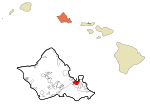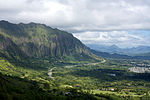Hoʻomaluhia Botanical Garden

The Hoʻomaluhia Botanical Garden (approximately 400 acres) is a botanical garden located at 45–680 Luluku Road, Kāne'ohe, Oahu, Hawaii. It is part of the Honolulu Botanical Gardens, and is open daily, without charge, except for Christmas Day and New Year's Day. The garden was established in 1982, and designed and built by the United States Army Corps of Engineers for flood protection. It is a rainforest garden, with plantings from major tropical regions around the world, grouped into distinct collections that focus on Africa, Hawaii, India and Sri Lanka, Malaysia, Melanesia, the Philippines, Polynesia, and the tropical New World. Special emphasis is placed on conserving plants native to Hawaii and Polynesia, as well as arecaceae, aroids, and heliconias. The garden includes a lake (32 acres) and walking trails, as well as a day use area, campgrounds, and a visitor center with lecture room, exhibition hall, workshop, and botanical library.
Excerpt from the Wikipedia article Hoʻomaluhia Botanical Garden (License: CC BY-SA 3.0, Authors, Images).Hoʻomaluhia Botanical Garden
Park Access Road, Kaneohe
Geographical coordinates (GPS) Address Nearby Places Show on map
Geographical coordinates (GPS)
| Latitude | Longitude |
|---|---|
| N 21.387777777778 ° | E -157.80805555556 ° |
Address
Pa Launa
Park Access Road
96744 Kaneohe
Hawaii, United States
Open on Google Maps






